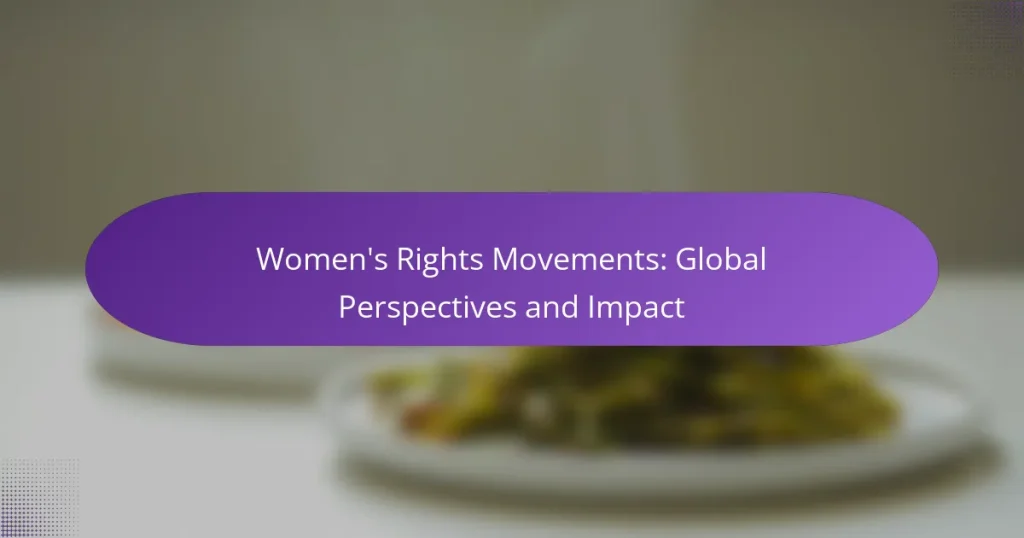Women’s rights movements around the world play a crucial role in advocating for gender equality, reproductive rights, and protection against gender-based violence. These initiatives have evolved to address diverse issues faced by women across different cultural and political landscapes, significantly influencing legislation and public policy. Despite their impact, these movements often face challenges such as societal resistance and financial constraints, which can impede their progress and effectiveness.
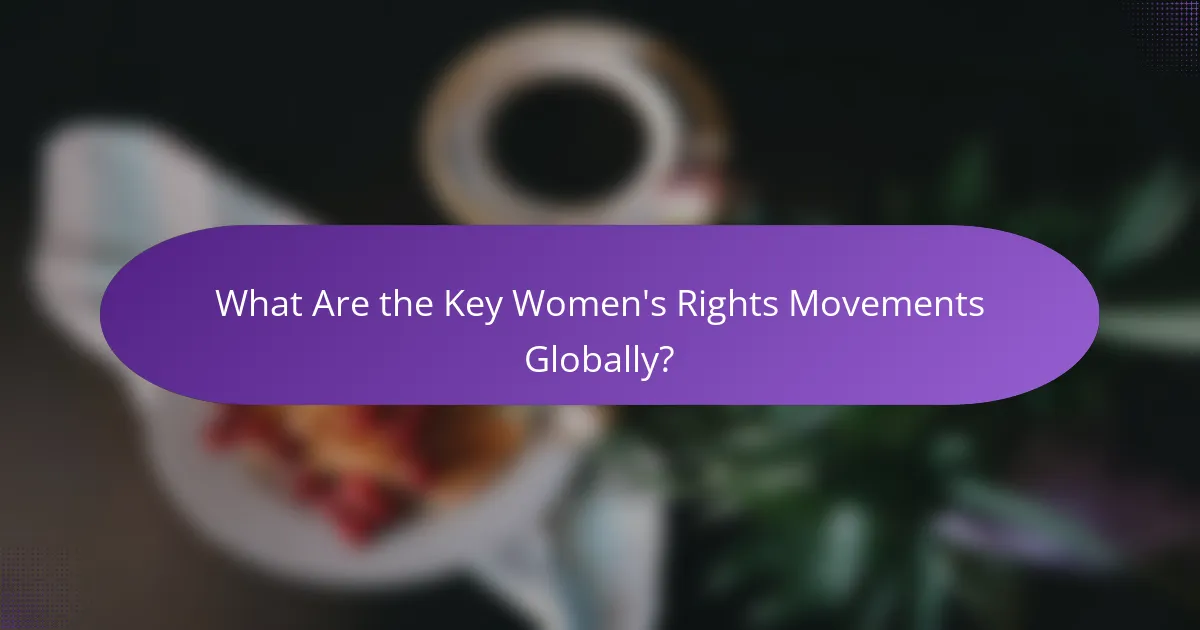
What Are the Key Women’s Rights Movements Globally?
Key women’s rights movements globally include initiatives that advocate for gender equality, reproductive rights, and protection against gender-based violence. These movements have evolved over time, addressing various issues faced by women in different cultural and political contexts.
Women’s Suffrage Movement
The Women’s Suffrage Movement focused on securing the right to vote for women, a fundamental aspect of political equality. This movement gained momentum in the late 19th and early 20th centuries, with significant milestones such as the 19th Amendment in the United States in 1920, which granted women the right to vote.
Globally, suffrage movements varied in their approaches and timelines, with some countries granting voting rights much earlier than others. For example, New Zealand was the first self-governing country to grant women the right to vote in 1893, while Saudi Arabia only allowed women to vote in 2015.
Me Too Movement
The Me Too Movement emerged as a social campaign against sexual harassment and assault, gaining widespread attention in 2017. It encourages individuals to share their experiences, thereby raising awareness about the prevalence of gender-based violence.
This movement has led to significant cultural shifts, prompting organizations to reevaluate their policies on harassment and creating safer environments for women. It has also inspired global solidarity, with similar movements appearing in various countries, highlighting the universal nature of the issue.
Women’s March
The Women’s March is a series of worldwide protests advocating for women’s rights, initiated in January 2017 in response to political events in the United States. The march emphasizes issues such as reproductive rights, healthcare access, and gender equality.
These marches have mobilized millions, fostering a sense of community and activism among participants. They serve as a platform for diverse voices, uniting various causes under the umbrella of women’s rights and social justice.
HeForShe Campaign
The HeForShe Campaign is a solidarity movement initiated by UN Women, encouraging men to advocate for gender equality. Launched in 2014, it aims to involve men in the fight against gender discrimination and promote shared responsibility for women’s rights.
This campaign highlights the importance of male allies in achieving gender parity, emphasizing that gender equality benefits everyone. It encourages men to take action in their communities and workplaces, fostering a culture of respect and equality.
Feminist Movements in Africa
Feminist movements in Africa address a range of issues, including gender-based violence, economic empowerment, and reproductive rights. These movements are often shaped by local cultural, social, and political contexts, leading to diverse approaches across the continent.
Organizations like the African Women’s Development Fund support grassroots initiatives, empowering women through education and advocacy. The movements aim to challenge patriarchal norms and promote women’s leadership in various sectors, contributing to broader societal change.
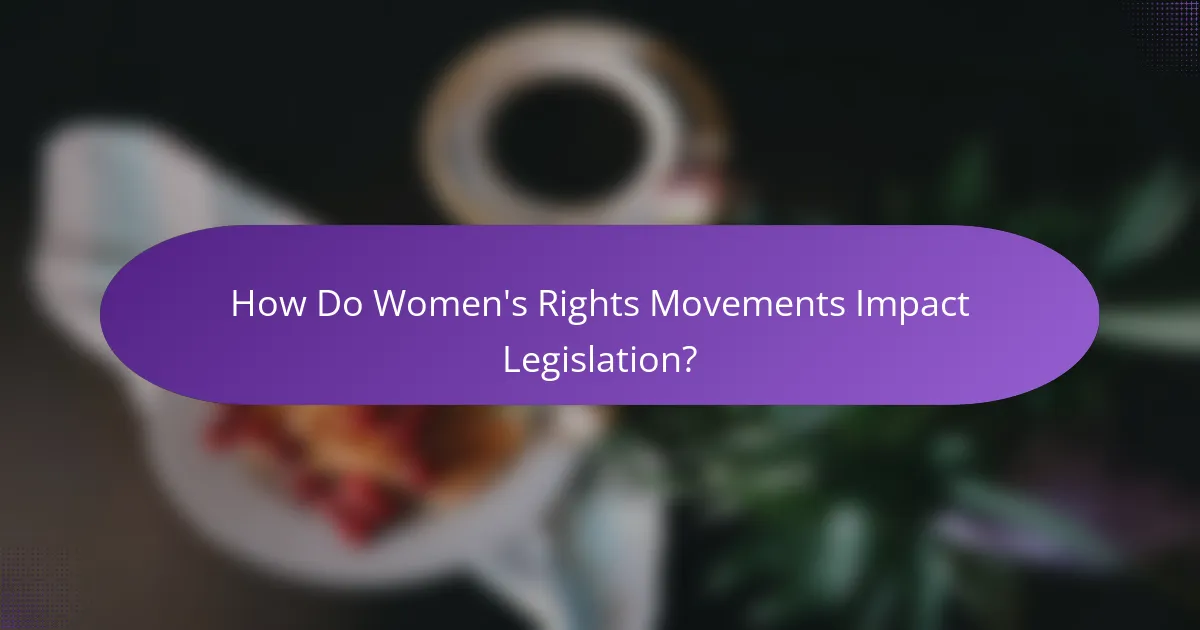
How Do Women’s Rights Movements Impact Legislation?
Women’s rights movements significantly influence legislation by advocating for laws that promote gender equality and protect women’s rights. These movements mobilize public opinion and pressure lawmakers to enact reforms that address issues such as voting rights, workplace equality, and gender-based violence.
Influence on Voting Rights
Women’s rights movements have historically played a crucial role in securing voting rights for women across various countries. Activists have organized campaigns, protests, and lobbying efforts that highlight the importance of women’s participation in the democratic process.
For instance, the suffrage movement in the early 20th century led to significant legal changes, such as the 19th Amendment in the United States, which granted women the right to vote. Similar movements in other nations have resulted in comparable legislative milestones, emphasizing the power of collective action.
Changes in Workplace Equality Laws
Women’s rights movements have been instrumental in advocating for workplace equality laws that ensure fair treatment and opportunities for women in the labor market. These movements have pushed for legislation addressing issues like equal pay, maternity leave, and anti-discrimination policies.
For example, the Equal Pay Act in the U.S. aimed to eliminate wage disparity based on gender, while many European countries have implemented directives to promote gender equality in employment. These legal frameworks are essential for fostering a more equitable work environment.
Legislation Against Gender-Based Violence
Women’s rights movements have raised awareness about gender-based violence and have been pivotal in shaping laws that protect victims. Advocacy efforts have led to the establishment of legal definitions of domestic violence and sexual harassment, as well as stronger penalties for offenders.
Countries like Sweden and Canada have enacted comprehensive legislation aimed at preventing gender-based violence and supporting survivors. These laws often include provisions for victim assistance and education programs to combat societal norms that perpetuate violence against women.
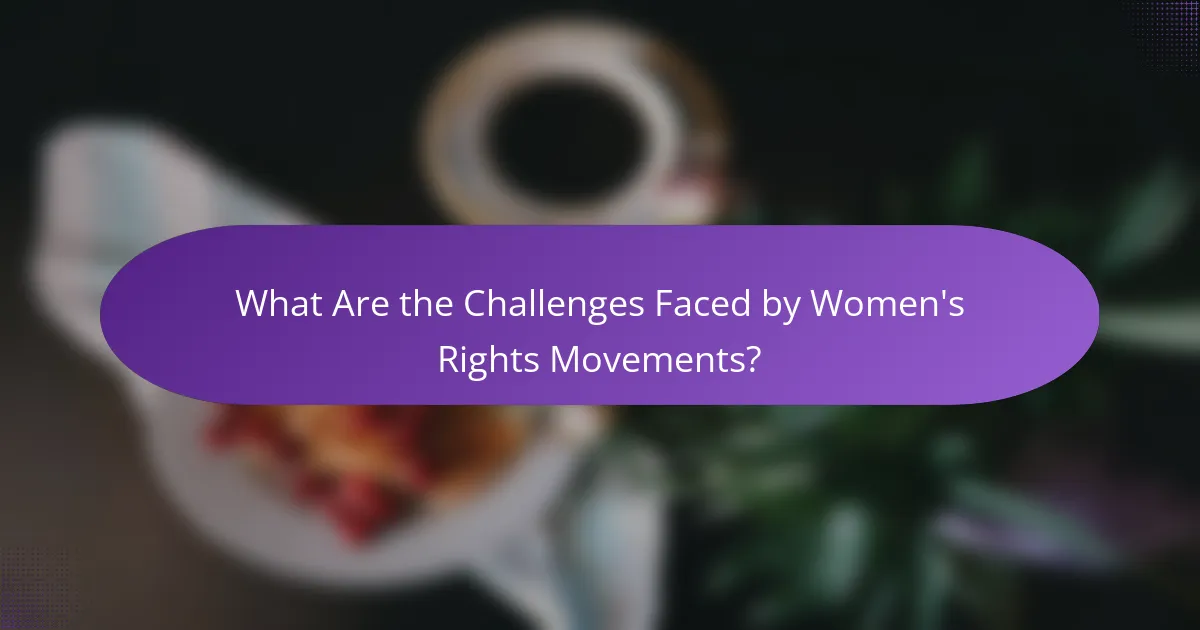
What Are the Challenges Faced by Women’s Rights Movements?
Women’s rights movements encounter various challenges that hinder their progress, including societal resistance, financial constraints, and significant global disparities. These obstacles can limit the effectiveness of advocacy efforts and the implementation of policies aimed at promoting gender equality.
Resistance from Traditional Norms
Traditional norms often dictate gender roles that restrict women’s rights and limit their participation in society. In many cultures, deeply ingrained beliefs about women’s place can lead to backlash against movements advocating for change. This resistance can manifest in social stigmas, legal barriers, and even violence against activists.
To combat this, movements often focus on education and awareness campaigns that challenge these norms. Engaging community leaders and influencers can also help shift perceptions and foster a more supportive environment for women’s rights.
Funding and Resource Limitations
Many women’s rights organizations face significant funding and resource limitations, which can impede their ability to operate effectively. These organizations often rely on donations, grants, and government support, which can be inconsistent and insufficient. As a result, they may struggle to maintain programs or expand their outreach.
To address funding challenges, organizations can diversify their funding sources, seek partnerships with businesses, and leverage social media for crowdfunding initiatives. Establishing strong networks can also enhance resource sharing among groups facing similar challenges.
Global Disparities in Women’s Rights
Women’s rights vary widely across different countries and regions, creating global disparities that complicate advocacy efforts. In some areas, women enjoy extensive rights and protections, while in others, they face severe restrictions and discrimination. This inconsistency can lead to challenges in forming a unified global movement.
Understanding local contexts is crucial for effective advocacy. Movements should tailor their strategies to address specific cultural, legal, and economic conditions in each region. Collaborating with local organizations can provide valuable insights and enhance the impact of global initiatives.
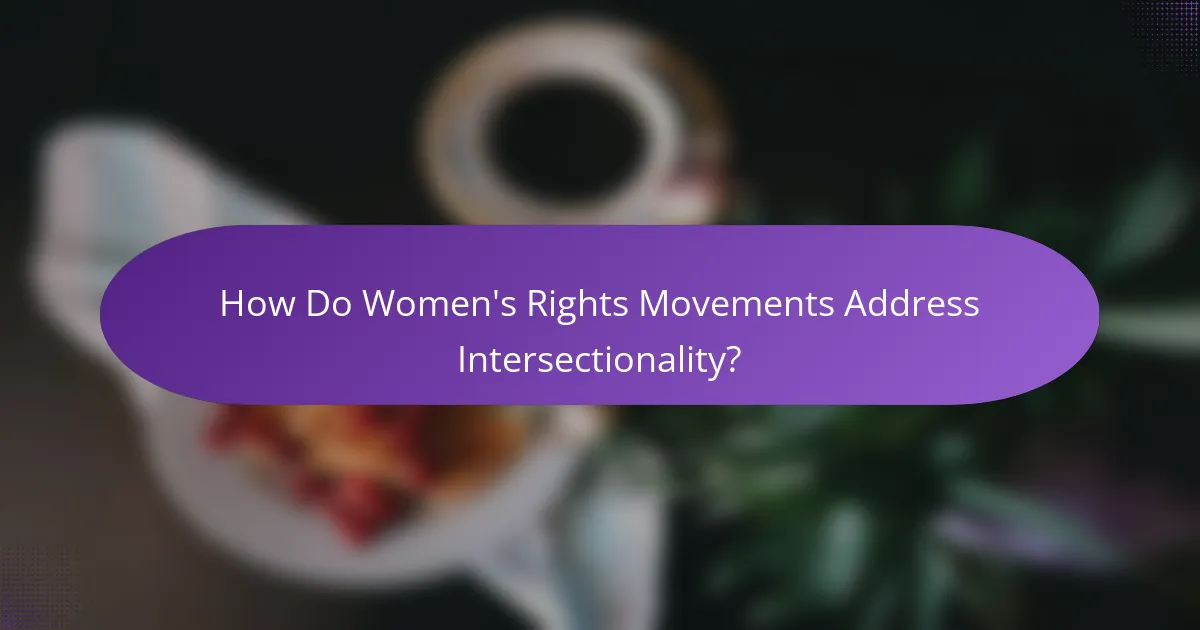
How Do Women’s Rights Movements Address Intersectionality?
Women’s rights movements address intersectionality by recognizing that various social identities, such as race, ethnicity, sexual orientation, and economic status, intersect to create unique experiences of discrimination and privilege. This approach ensures that advocacy efforts are inclusive and effective for all women, particularly those facing multiple forms of oppression.
Focus on Race and Ethnicity
Race and ethnicity play a crucial role in shaping women’s experiences and challenges. Women’s rights movements often highlight the disparities faced by women of color, who may encounter systemic racism alongside gender discrimination. For instance, issues like healthcare access, education, and employment opportunities can differ significantly based on racial and ethnic backgrounds.
Advocacy groups work to amplify the voices of women from diverse racial and ethnic communities, ensuring their specific needs and concerns are addressed. This includes pushing for policies that combat racial discrimination and promote equity in various sectors.
Inclusion of [censured] Perspectives
Incorporating [censured] perspectives is essential for a comprehensive understanding of women’s rights. [censured] women often face unique challenges, including discrimination based on both gender and sexual orientation. Movements that embrace these perspectives advocate for equal rights, protection against violence, and access to healthcare tailored to their needs.
By recognizing the intersection of gender and sexual identity, women’s rights movements can create more inclusive spaces that address the specific issues faced by [censured] individuals, such as legal recognition of relationships and protection from hate crimes.
Economic Status Considerations
Economic status significantly impacts women’s rights and access to resources. Women from lower economic backgrounds may struggle with barriers such as limited job opportunities, wage gaps, and inadequate access to education. Women’s rights movements aim to highlight these economic disparities and advocate for policies that promote economic empowerment.
Efforts often include initiatives for fair wages, affordable childcare, and access to education and job training programs. By addressing economic inequalities, movements can help create a more equitable society for all women, regardless of their financial situation.
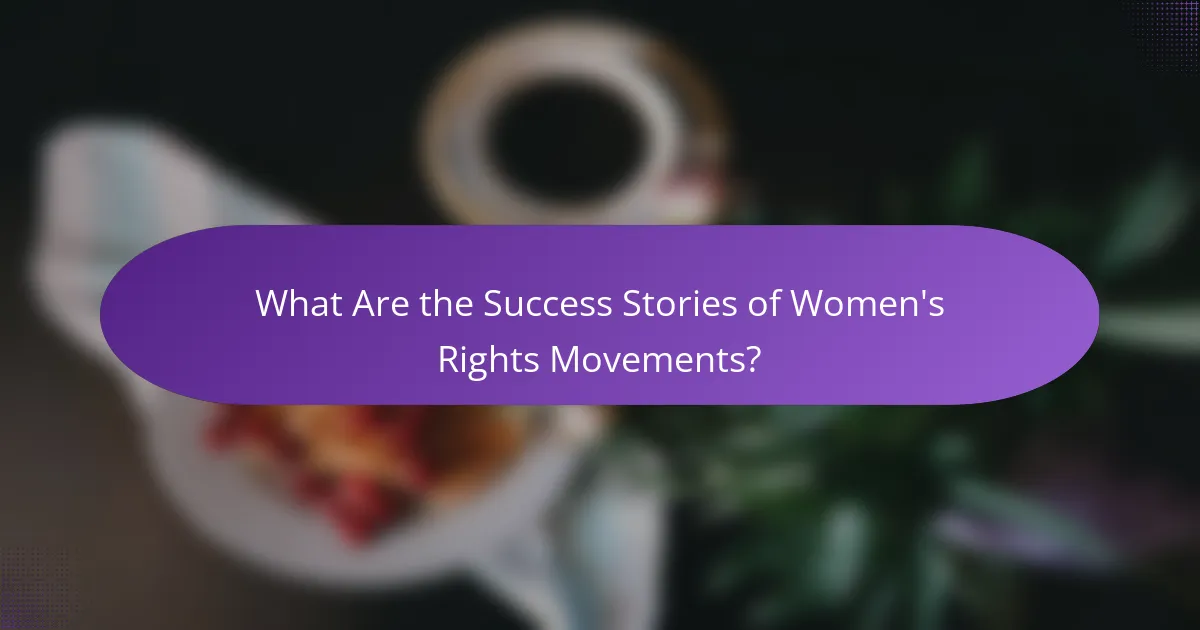
What Are the Success Stories of Women’s Rights Movements?
Women’s rights movements have achieved significant milestones globally, improving legal frameworks, access to education, and social norms. These successes vary by region, reflecting local contexts and challenges.
Legal Reforms in Nordic Countries
Nordic countries are often cited as exemplars of women’s rights due to their comprehensive legal reforms. These nations have implemented policies that promote gender equality in various sectors, including labor, health, and education.
For instance, laws ensuring equal pay for equal work and parental leave policies that encourage shared responsibilities between mothers and fathers have been pivotal. The Nordic model emphasizes not just legal equality but also practical support systems that facilitate women’s participation in the workforce.
Access to Education in Afghanistan
Access to education for women in Afghanistan has seen both progress and setbacks, especially following recent political changes. Despite challenges, grassroots movements and international support have led to increased enrollment rates for girls in schools.
Organizations working on the ground have focused on creating safe learning environments and providing scholarships to encourage families to send their daughters to school. While the situation remains precarious, the resilience of Afghan women and their advocates continues to push for educational opportunities.
